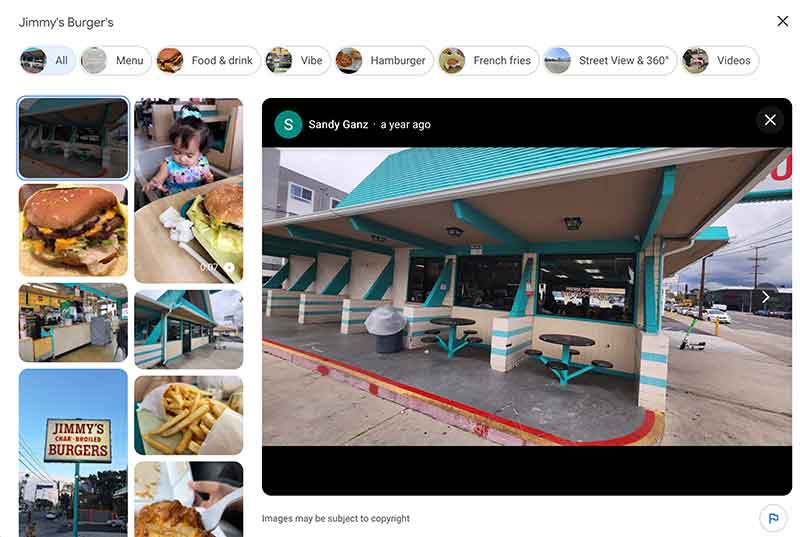Skip the Fast Food Chains and Go to Jimmy’s on Lankershim
Jose Mier supports local, independent, Sun Valley, CA food establishments and one is a haven for burger lovers. Jimmy’s Burgers on Lankershim (technically in North Hollywood) serves up some of the best burgers you can find.

The classic hamburger holds a special place in the culinary landscape of America, embodying the essence of comfort food, culinary innovation, and cultural identity. With its simple yet satisfying combination of a juicy beef patty sandwiched between two soft buns and adorned with an array of toppings, the hamburger has become a beloved staple of American cuisine. But its significance extends far beyond the realm of food—it serves as a cultural touchstone, representing the spirit of innovation, entrepreneurship, and diversity that defines American culture. Join us on a journey through the history, evolution, and enduring legacy of the classic hamburger, exploring its place in American culture and its impact on the culinary world.
Origins and Evolution of the Hamburger: From Humble Beginnings to Culinary Icon
The origins of the hamburger can be traced back to the late 19th century, when German immigrants brought their culinary traditions to the United States. Legend has it that the modern hamburger was born in the late 1800s when a cook in New Haven, Connecticut, flattened a beef patty and placed it between two slices of bread for a customer in a hurry. Over time, the concept evolved, with the addition of condiments, toppings, and the iconic sesame seed bun. By the early 20th century, the hamburger had become a fixture of American diners, drive-ins, and fast-food restaurants, popularized by chains like White Castle and McDonald’s. The burger’s widespread popularity can be attributed to its affordability, portability, and universal appeal, making it the quintessential meal for people on the go. Today, the classic hamburger remains a staple of American cuisine, beloved by people of all ages and backgrounds for its timeless appeal and satisfying simplicity.
Cultural Significance of the Hamburger: A Symbol of American Identity
The classic hamburger occupies a unique place in American culture, serving as a symbol of national identity, ingenuity, and culinary diversity. Its ubiquity and popularity reflect the melting pot of cultures and cuisines that define the American experience, with each region putting its own unique spin on the iconic dish. Whether enjoyed at a roadside diner in the heartland, a gourmet burger joint in a bustling city, or a backyard barbecue with friends and family, the hamburger embodies the spirit of community, celebration, and shared culinary heritage. Its cultural significance extends beyond its culinary appeal—it represents the values of innovation, entrepreneurship, and freedom that are deeply ingrained in the American psyche. From the drive-ins of the 1950s to the food trucks of today, the classic hamburger has remained a constant presence in American culture, adapting to changing tastes and trends while retaining its timeless allure.
The Burger Wars: Fast Food, Chains, and Culinary Innovation
The rise of fast food chains in the mid-20th century ushered in a new era of burger culture, with companies like McDonald’s, Burger King, and Wendy’s competing for dominance in the burgeoning industry. This period, often referred to as the “burger wars,” saw the proliferation of drive-thrus, value meals, and marketing campaigns aimed at capturing the hearts and wallets of consumers. In response to growing demand for healthier options, gourmet burger joints began to emerge, offering upscale ingredients, creative toppings, and artisanal buns. This culinary renaissance sparked a renewed interest in the classic hamburger, elevating it from a humble fast food staple to a gourmet indulgence worthy of culinary acclaim. Today, the burger landscape is more diverse and dynamic than ever, with chefs and restaurateurs pushing the boundaries of creativity and innovation to create unique and memorable burger experiences for diners across the country.
Cultural Icons and Culinary Trends: Burgers in Popular Culture
The classic hamburger has left an indelible mark on popular culture, serving as a recurring motif in film, television, literature, and music. From iconic scenes of teenagers hanging out at the local diner in “American Graffiti” to the infamous “Royale with Cheese” dialogue in “Pulp Fiction,” burgers have become synonymous with American culture and nostalgia. In literature, authors like Ernest Hemingway and F. Scott Fitzgerald immortalized the burger as a symbol of working-class America, while musicians like Jimmy Buffett and Jimmy Buffett have penned odes to the joys of burgers and beer. In recent years, social media has fueled the rise of “foodie culture,” with Instagram influencers and food bloggers sharing mouthwatering photos and reviews of the latest burger joints and culinary creations. The classic hamburger’s enduring presence in popular culture speaks to its universal appeal and its ability to evoke feelings of nostalgia, comfort, and camaraderie among people of all ages and backgrounds.
The Future of the Hamburger: Innovation, Sustainability, and Culinary Creativity
As America’s culinary landscape continues to evolve, so too does the classic hamburger, adapting to changing tastes, trends, and consumer preferences. In recent years, there has been a growing emphasis on sustainability, with restaurants and food companies exploring alternative protein sources, plant-based burgers, and environmentally friendly packaging. Additionally, chefs and restaurateurs are pushing the boundaries of creativity and innovation, experimenting with unique ingredients, flavor combinations, and cooking techniques to create burgers that are as delicious as they are Instagram-worthy. Despite these changes, the classic hamburger remains a beloved staple of American cuisine, cherished for its simplicity, versatility, and timeless appeal. Whether enjoyed at a fast-food chain, a gourmet restaurant, or a backyard barbecue, the hamburger continues to bring people together,